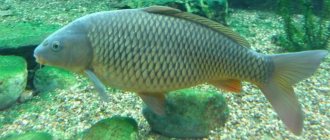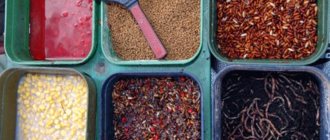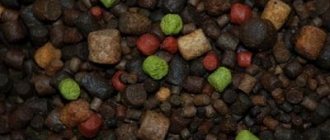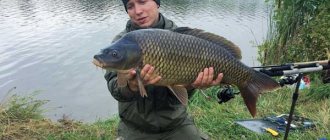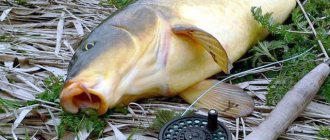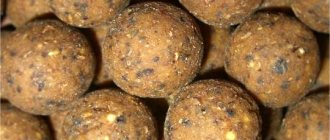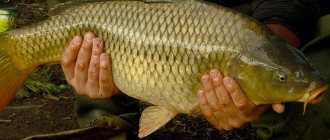Why potatoes?
Carp is a lover of starch - it is often added as a binding component to various baits, and potatoes contain a huge amount of starch. In addition, potatoes have high nutritional value, and their smell is very attractive to carp.
In addition to the fact that the root vegetable is of interest to carp, it is ideal from the angler’s point of view - there is no need to talk about its availability, as for the technical part - from boiled tubers you can cut bait of various sizes to catch carp or carp of different sizes. Also, this bait holds perfectly on the hook, withstanding even long casts.
Potato nozzle shape
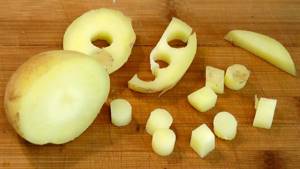
Again, every fishing enthusiast must experimentally select the configuration of the nozzle. Baits can be of two options:
- Rectangular shape. In this case, the cooked potatoes are cut into squares, the side of which should be approximately one centimeter, maximum two. The size of the side is influenced by the hook number and the size of the fish. Naturally, the larger the carp, the larger the rectangle of the bait should be.
- Cylindrical shape. To prepare such a nozzle, you will need a syringe with the tip cut off. You need to take a potato slice and simply squeeze a cylinder out of it with a piston.
What kind of potatoes should I use?
is of great importance - the number of bites and, as a consequence, the result of fishing directly depends on this.
Under no circumstances should you take tubers that are moldy, rotten, green in the sunlight or have withstood freezing. The fruit must be firm and juicy and not have an unpleasant odor. It can vary in size, but it is most convenient to cut the bait from tubers approximately the size of a tennis ball.
In the summer, many fishermen have a completely logical question - which potatoes will be more effective - the old or new harvest. If the root crop is well preserved, has not withered or been frozen, then it is better to use the old tuber, as it contains more starch and nutrients, which plays a decisive role in its attractiveness to carp . In addition, young potatoes are less dense and will stay on the hook much worse.
Suitable tackle
Small fish do not pay attention to potatoes. Most often, when using such a bait, anglers expect to catch carp, large roach, crucian carp or bream. Catching such fish often takes place at a considerable distance from the shore, which means that you will need appropriate gear - long-range and with a solid margin of safety.
A fishing rod suitable for these purposes is a heavy-class feeder with a fast or progressive action if you plan to catch river fish, and a parabolic or progressive one if you plan to catch large carp (however, for the targeted fishing of this particular fish, it is better to use special carp fishing rods).
A reel for such powerful rods needs a suitable one. It is worth giving preference to inertia-free reels, starting from size 5000-6000 (larger reels are also used for carp rods). It is highly desirable to have a baitrunner - this device will allow you not to worry about gear when biting large carp.
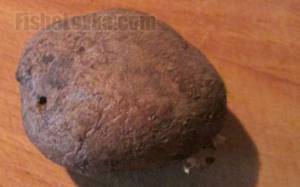
Photo 1. Regular potatoes.
When catching large fish, both fishing line and braided line are used. Both options have their advantages and disadvantages. Braid makes the tackle more sensitive due to its low elongation, but this same property turns from an advantage into a disadvantage when a trophy specimen is hooked. Although the fishing line has less tensile strength with the same diameter, when stretched it is capable of absorbing the jerks of the trophy.
How to cook potatoes for carp and carp
Although boiling potatoes is a very simple process, it is important to know and follow some nuances when preparing them. The recipe for cooking potatoes for carp fishing is as follows:
- Select large, smooth tubers and wash them along with the peel. You should not peel the potatoes, as the water will make them loose.
- Throw the potatoes into boiling water and cook until almost done . The toothpick should enter the tuber with some effort. It is better to undercook a tuber than to overcook it.
- Drain the water and cool the tubers.
- Peel the potatoes and cut into pieces.
- Fry the nozzle in unrefined sunflower oil until light golden brown. Frying is not a necessary process, but this way the bait will be better held on the hook, and the smell of sunflower oil will increase its attractiveness to fish.
Important! When frying potatoes, you should never allow them to burn, as this smell will repel the carp and significantly reduce the number of bites.
Some fishermen use natural flavors by adding garlic or dill to the water when cooking. You can also use concentrated aromatic additives - anise, strawberry, chocolate and others, selecting them to suit the taste preferences of the carp at certain times in different bodies of water.
Sometimes potatoes are tinted in different colors, in the belief that such a move will increase their attractiveness to carp, but many carp fishermen have noted that the color of potatoes plays a role only in some individual reservoirs . There is also a risk that the smell of the dye will be unpleasant for the carp.
Attention! It is not recommended to use potato dyes in spring and autumn.
How to cook potatoes for carp fishing
Potatoes are an inexpensive product that can easily be used when going fishing. It is extremely rare for carp to refuse a delicacy offered to them. They often eat it with pleasure, and in just a couple of minutes.
If it was noticed that the fish does not bite or even swim up to the potatoes, it means that it was fed with boilies to such an extent that it has no time for root vegetables. True, experienced fishermen note that if the dish is served correctly, and before that it is properly prepared, then even the most well-fed specimen will not be able to swim past such a tasty treat.
Important! In order for potatoes to yield a good catch, they must be cooked correctly.
Many fishermen adhere to the following recipe, which has never let them down:
- It is necessary to take a good and ripe root vegetable (it is advisable to discard young potatoes, because they do not yet have that rich smell that is present in older specimens). Next, you should rinse it thoroughly to avoid adhering dirt and other debris.
- Pour water into a large container and place the pan on the fire.
- After the water boils, put the prepared potatoes into it. Many fishermen make the mistake of boiling a root vegetable, which they put in cold water and then bring it to a boil, believing that there is no difference. It is, in this case the potatoes will be more watery, which will affect the final result of the bait.
- After boiling, you will need to add dill or a few cloves of garlic to add flavor to the potatoes.
- The potatoes should be simmered over low heat until almost done. Care should be taken to ensure that the product does not overcook.
- When the dish is cooked, you can remove it from the heat and wait until it cools completely.
- After this, the potatoes are cut into small pieces (small, not too small, you should pay special attention to this). If you want, you can remove the peel, but this is not necessary.
It is advisable to cook potatoes the day before fishing so that they do not sit in the refrigerator for too long.
Gear for fishing with potatoes
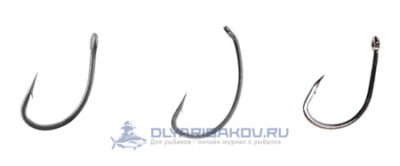
It is better to take leashes with a thickness of about 0.15 mm, preferably from nylon thread, since it is softer and the carp will not be alarmed by the resistance of the tackle when biting. The length of the main line should be sufficient not only to make a long cast, but also to release the carp a little in order to tire the hooked fish - you need to remember that carp and carp are very strong fish that offer powerful resistance when fishing.
Carp hooks should be used with a short shank. The size depends on the expected size of the fish, but most often they take No. 3 according to the European classification or No. 10-12 according to Russian . Some fishermen use a tee for a more reliable hook.
How to choose gear for carp
Whole potato attachments (boiled)
For cooking, you need to choose tubers that contain a lot of starch. In May - June, it is better to use last year's potatoes to prepare bait, as they are starchier and less watery than new ones.
Recipe: wash one or several small tubers of regular shape well with a brush and place in boiling unsalted water. The cooking time depends on the variety. A properly prepared potato bait should be dense enough so as not to fall apart during a long cast, but also so soft that the fish will take it without much effort (carp does not swallow food, like predators, but gently sucks it in). Therefore, in this case, it is better to slightly undercook the tubers than to overcook them.
After about 12-13 minutes of cooking, taste the potatoes with a toothpick. If the flesh is easily pierced, the potatoes are ready; if not, you can cook for a few more minutes.

Sufficient degree of cooking
Experienced fishermen argue about how to cook potatoes for carp: some prefer the classic method described, others add a little salt to the water and cook a sprig of dill, a few slices of carrots and beets along with the potatoes. If there is absolutely no time, then you can even use potatoes from borscht or soup, the main thing is that the pulp does not crumble. After several options, each fisherman individually selects the bait option.
The cooked tubers are removed from the water and allowed to cool. After this, they either cut them right away, or take whole potatoes with them, and make attachments on the spot as needed.
There are two types of whole potato attachments:
- Cubes. Using a knife with a thin blade, cut a slice from the tuber cooked in its uniform and cut it into cubes with a side of 8–10 mm. The size of the cube depends on the hook and the size of the carp you are going to catch: for large fish, the bait should be larger.
- Cylinders. The tip of the medical syringe, to which the needle is attached, is cut off with a knife. Then take a slice of potato 8–10 mm thick, squeeze out a cylinder with a tube and push it out of the syringe with a piston.
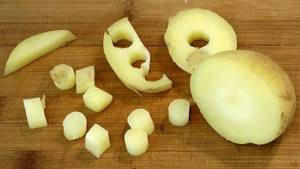
"Cubes" and "cylinders"
If you make the attachments at home, you can heat unrefined sunflower oil in a frying pan and fry the preparations a little (literally a minute so that the crust does not become too hard).
How to put potatoes on a hook
Usually the potato bait is attached directly to the hook. In this case, the hook tip should pass diagonally across the cube. When using a tee, it is completely hidden in the nozzle. The tip of the hook should protrude slightly from the bait for better carp detection.
When catching trophy carp or carp, you should remember that it can be scared away by a bait with hooks hidden in it, so in this case, a hair rig will be the best. The potatoes stick well to the hair and are easy to change if necessary.
Do you need flavorings?
You should not use any flavorings when fishing with potato cubes or balls. The smell of boiled potatoes already attracts carp fish quite well.
However, you can add a minimum amount of various oils (hemp, sunflower, flaxseed, etc.) to attract fish if the potatoes for bait are mixed with bread. Potatoes are often mixed with millet or corn porridge, adding a little wheat flour to the mixture for viscosity.
Read! Fishing with foam balls
Fishing with mashed potatoes
Catching carp with potatoes is possible not only with cubes, but also with mashed potatoes made from tubers. It is prepared according to this recipe:
- A few unpeeled tubers are boiled for 15 minutes until tender, depending on their size.
- When the potatoes are ready, peel them and grate them on a fine grater.
- Add a little butter, one tablespoon of honey and less than a teaspoon of salt to the grated potatoes. Everything is mixed until a homogeneous mass is obtained.
- With continuous stirring, flour is poured until a thick mass is obtained, reminiscent of dense dough.
- The mass is formed into pellets of the required size, which are thrown into boiling water and cooked for about 20 minutes.
Attention ! Potato baits for catching carp must be freshly prepared. It is recommended to prepare them no earlier than the day before the start of fishing. Long-term storage can reduce the number of bites.
Bait when fishing for carp using potatoes
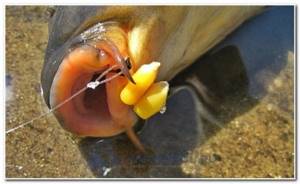
The following ingredients are suitable for preparing the bait mixture :
- Sunflower seed cake.
- Canned corn.
- Bran.
- Various cereals.
You need to add some mashed potatoes to the bait. In this case, the bait on the hook will look more natural and beneficial for the carp, which came to the smell of the bait mixture.
Potato is a budget-friendly and effective bait for catching carp and carp, successfully competing among amateur fishermen with expensive baits - it is simple and quick to prepare without unnecessary time and material costs.
Carp fishing tactics
Let’s literally briefly go over the main points of carp fishing. In fact, this requires a separate article or even several, but we will analyze only the most important and suggestive of the right thoughts. Let's talk about gear, choosing a place, fishing time and the need for bait.
Where to look
Carp can either stand in holes in the middle of the reservoir or approach the very shoreline. This fish is a schooling fish, so if you choose the right promising place, then schools of fish will approach your bait regularly and fishing will be successful. Standard promising places for carp fishing are:
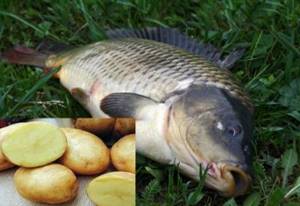
holes and dumps at a distance from the shore;- areas under the opposite bank, if there is no access to it from that side (when fishing on small carp ponds);
- trees, snags, flooded bushes, etc., fallen into the water;
- carp does not like noisy places, so you should look for it away from beaches and large crowds of people;
- thickets of reeds often become the entry point for a school of carp; here they can be caught in windows of vegetation or from the edge where the reeds begin. Using a float rod, you can put the bait directly into the thick of the reeds, which often brings good results. The presence of carp in the reeds can be seen by the way the vegetation moves when the fish rubs against it.
Promising places where carp can be found may change depending on weather conditions and the fishing season, but we have analyzed the main areas that you should pay attention to first.
When to catch
Carp is a heat-loving fish, so its activity increases with temperature. In winter it practically does not bite, although there are certain tricks that allow you to catch this fish in winter.
The best fishing period is summer, as well as late spring and early autumn. The best time of day for fishing is morning, evening and night. During the day it can peck only at low air and water temperatures.
A small carp up to a kilogram can be active around the clock, but large individuals usually begin to feed only at dawn and at night, and during the day they do not show any interest in the fisherman’s baits.
Tackle
Carp are caught with both bottom tackle and float rods. Bottom gear is more effective, with some exceptions when fishing takes place in reed thickets or near a tree fallen into the water a short distance from the shore. At night, carp often come a short distance from the shoreline, so using float rods at this time can also bring good results.
In fishing stores there are special carp rods that are designed specifically for catching this fish; they are very powerful and comfortable, allowing you to cope even with a large trophy. A carp fishing rod should be chosen with a length of 3.6 meters, a fishing line with a diameter of 0.3-0.35, a hook No. 2-8, a powerful reel with a good drag and a baitrunner.
Lure
Without bait, you shouldn’t even think about targeted carp fishing. If you want to fish successfully, you will need a lot of bait. If you use a store-bought one, it will be quite expensive. Therefore, ryba4ok.ru recommends making bait for carp yourself. This will save a lot of money and is very easy to do.
In order to make good bait, all you need to do is go to the market and buy some suitable ingredients:
- peas;
- corn;
- millet;
- halva;
- cake;
- semolina;
- pearl barley;
- cake;
- breadcrumbs.
One of the simplest options is millet with halva. It’s enough just to cook the millet and when it’s ready, mix it with halva. In this way, you can prepare a sufficient amount of bait in half an hour and it will turn out to be several times cheaper than store-bought bait. And then you can experiment and add different ingredients to the bait or replace them. But when fishing with potatoes, it is advisable to add it to the bait, then the fish will take your bait more confidently.
That's all the basics of carp fishing with corn. I hope our article helped you a lot or at least revealed the main points that you wanted to know. We are waiting for you on our website. No tail, no scales!
